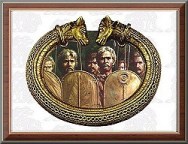














This is known historical fact.
But the Roman invasion of Scotland backfired on the centuries-old Empire; it united the Pictish clans under one man; Calach.
This website is the story of the first documented invasion of Scotland.


From Tacitus' biography and other Roman writings we have the terms Caledonia, Pict, he first gives names to the Clyde and Tay rivers,and much more. Tacitus gives first mention to the Pictish leader, calling him Calgacus, or Galgacus but for the rest of the text I will use a more gaelic, less latin version; 'Calaich' or 'Calach', meaning "The Swordsman".
 The aims of the website
The aims of the website

In this website, we hope to examine the facts as they stand, without strict reference to "accepted" text-book history, and offer some intelligent, structured conjecture.
We base our postulations on a knowledge of Roman military tactics, a modern analysis of Tacitus' writings and up to date archeaological data. Through these, we try to rationalise what information is available to us, and hopefully come to a reasonable set of conclusions.
 Points not in dispute....
Points not in dispute....
To continue the story, press the continue key.



Links to useful associated resources:
Elmsella Family Scottish Website
Rampant Scotland; Great directory!
Go to Scottish search to rate this site!
Thanks are given here to the Ermine Guard, who's permission to show many of the images has both enhanced the look, and, hopefully, made the website more interesting.
Thanks also to Karla, my wife, for her constant support, her ideas, critisism, and for most of the action photos from the Roman/Pict day at Archeaolink.
There's no guestbook (because it got corrupted), but if you have any views on the above, (good or bad)please feel free to
e-mail me.






 |
The Celtic Pride SiteRing This site owned by
|
 |
THE CELTIC PUB RING This site owned by [Calach's Story] |
|
|
|

This RingSurf Advancement of Scottish and Celtic Heritage Net Ring
owned by Calach's Story.
[ Skip Next | Next 5 Sites | Random Site | List Sites ]
Content copyright © 2000 held by the author; Ian Hall.
